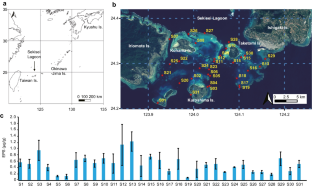2025-03-07 北里大学
<関連情報>
- https://www.kitasato.ac.jp/jp/news/20250307-01.html
- https://www.kitasato-u.ac.jp/jp/albums/abm.php
- https://link.springer.com/article/10.1007/s10126-025-10412-5
サンゴの減少は、日本の石西礁湖で証明された沿岸の石灰質堆積物由来の海水中の交換性リン酸に関連している Coral Decline Linked to Exchangeable Phosphate in Seawater from Coastal Calcareous Sediments, as Evidenced in Sekisei Lagoon, Japan
Jun Yasumoto,Mariko Iijima,Akira Iguchi,Takashi Nakamura,Ryogo Takada,Mina Yasumoto-Hirose,Yuichi Iwasaki,Tetsuo Yasutaka,Kanami Mori-Yasumoto,Ryuichi Shinjo,Ryota Ide,Alice Yamazaki,Nanami Mizusawa,Yoshikazu Ohno,Atsushi Suzuki,Shugo Watabe & Ko Yasumoto
Marine Biotechnology Published:04 March 2025
DOI:https://doi.org/10.1007/s10126-025-10412-5

Abstract
Coral reefs are essential for biodiversity and ecosystem services, yet they face threats like bleaching and reduced resilience due to rising seawater temperatures and land-based pollution. This study examined phosphate accumulation in calcareous sediments and its relationship with coral populations in Sekisei Lagoon, Okinawa Islands, Japan. Sediment samples from 117 sites were analyzed for exchangeable phosphate in seawater (EPS), which could be released from the calcareous sediments. The EPS levels were negatively correlated with coral densities for adults (Pocillopora, Acropora, Galaxea, Favia, Favites, Goniastrea, and Cyphastrea) and juveniles (Pocillopora, Montipora, Acropora, Galaxea, Favia, Favites, and Goniastrea). No significant correlation was found for Porites or Millepora. The EPS levels were positively correlated with coral bleaching and the abundance of Sargassaceae algae. High coastal EPS levels suggest main pollution sources from livestock and shrimp farming. The threshold above which EPS impacts coral bleaching and density was estimated at 0.3–0.7 µg/g, providing insights for coral reef conservation.



